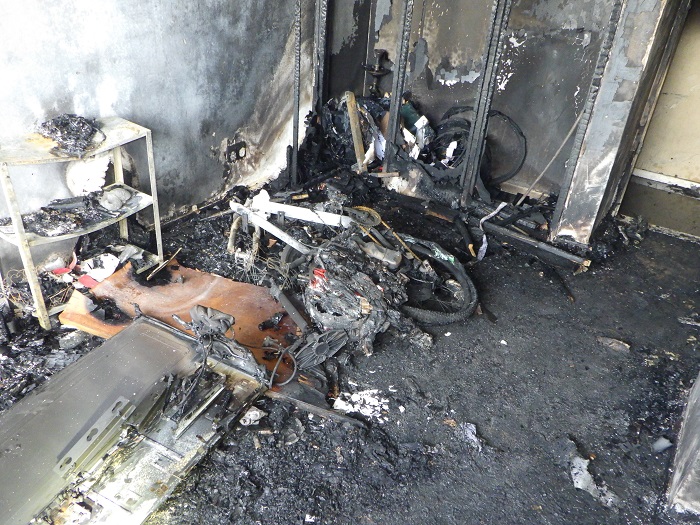Recent figures from the London Fire Brigade (LFB) make for sobering reading: as of 28 September 2025, there have been 165 fires involving e-bikes and e-scooters in London — of which 134 were e-bike fires alone. That equates to an average of around 18 incidents per month. If that trend continues through the final quarter, London may well exceed 200 such fires in one year for the first time.

Credit London Fire Brigade
What’s happening — and why it matters
These incidents aren’t just numbers. One fire in June claimed the life of a 30-year-old woman in a bedsit on Lordship Lane in Wood Green. The LFB’s Fire Investigation Team concluded the blaze was most likely caused by the failure of a charging lithium-ion battery pack from an e-bike.
This was the fourth fatal e-bike fire in London, and in each case the person who died did not actually own or ride the affected e-bike.
Other recent incidents underlining the danger include:
- 22 September: a man suffered serious burns after a converted e-bike charged in a flat in Putney High Street caught fire.
- 18 September: a woman made a dangerous escape (via first-floor window) in Downham after a charging e-bike triggered a house fire.
- 19 August: a charging battery pack for a converted e-bike failed in a Lewisham flat; a woman was hospitalised in life-threatening condition.
- 19 June: approximately 80 firefighters tackled a fire at a block of flats in North Pole Road, North Kensington. Nine people were rescued. The suspected cause: a lithium battery pack for a trike-style scooter, using aftermarket chargers & batteries.
Contributing factors
What is driving this spike in incidents? According to the LFB:
- Most fires stem from lithium-ion batteries failing — often while charging. Equipment is being overloaded, batteries overcharged, used with incorrect or non-approved chargers.
- Many fires involve conversion kits or batteries/chargers bought online from marketplaces, which may not have been subject to the same safety regulation as those in high-street shops.
- Change of storage/charging location also plays a part: batteries being kept or charged in communal stairwells, hallways or flats (especially in multi-occupancy residences) can block escape routes and turn what may seem a modest fire into a life-threatening incident.
Implications for safety professionals & schools
From my perspective — especially working with schools, foundries, safety-training and incident-management apps like Marshal Eye — this trend absolutely demands attention. Key take-aways:
- If you’re responsible for a building or site (e.g., a school, staff accommodation, student halls, multi-occupancy flat above a school, etc.), you need to treat e-bikes and e-scooters as a fire hazard, particularly where batteries are stored or charged.
- Charging batteries unattended, especially overnight or in hidden areas, is a major risk. If charging takes place in a corridor, store-room or flat, an ignition may rapidly spread.
- Review policies and physical infrastructure: are there dedicated, well-ventilated spaces for charging? Are batteries kept away from escape routes? Is the wall socket and charger configuration safe? Liability may lie with those managing the property.
- For your Marshal Eye app: this is exactly the kind of “emerging risk scenario” your critical-alerting, digital reporting and false-alarm-management tools must accommodate. You will want features that allow rapid recording of battery-charging risk environments, prompt notifications to maintenance/property teams, and incident-logging/reporting for audit.
- Staff, residents or users need clear guidance. Even if their job doesn’t involve direct safety operations, awareness is key: e-bikes may seem benign but the battery fires are far from trivial.
What the authorities are saying
Assistant Commissioner for Prevention & Protection at the LFB, Pamela Oparaocha, summarised:
“We continue to see the devastating consequences of e-bike and e-scooter fires in London… Fires involving e-bikes and e-scooters are worryingly common in London. Since the beginning of 2023, we have attended a fire, on average, every other day…”
The LFB’s #ChargeSafe campaign (launched in 2023) urges public awareness of these risks but the rising incident count shows more needs to be done. The legislation front is also developing: e-bike battery regulation, especially for online-marketplace products, remains a focus.
Practical safety steps to implement
Here are my recommended measures — both for building-managers and for anyone responsible for safety oversight:
- Use trusted products only — Go for e-bikes, batteries and chargers from reputable suppliers; avoid non-branded conversion kits or second-hand batteries, unless fully certified.
- Charge in safe locations — Ideally in a well-ventilated area, no combustible material nearby, away from escape routes. Avoid charging overnight unattended in a sleeping area.
- Monitor chargers & sockets — Avoid overloaded sockets, uncoiled extension leads, hidden cables; ensure chargers aren’t lying under cover, under cushions or in confined spaces.
- Check condition of batteries — If a battery has been dropped, damaged, overheats, bulges, or has been modified, it should be removed from use and disposed of safely.
- Develop policy for communal charging/charging rooms — Especially in student halls, multi-occupied flats, staff housing: set rules for where and how batteries are stored/charged, and ensure escape routes are clear.
- Ensure detectors & escape plans are in place — Local fire guidance recommends heat‐alarms or smoke alarms in charging rooms, and ensure occupants are aware of escape routes.
- Record & respond via digital tools — For example through the Marshal Eye platform, record incidents of unsafe charging/storage, send alerts to property managers, schedule inspections, and audit follow-up.
Closing thought
With e-mobility devices becoming ever more common — especially in dense urban settings — the risk from faulty or poorly maintained lithium-ion batteries should no longer be viewed as a “one-off” or rare event. The statistics from London are a clear warning: what might seem a convenient charging location or cheap conversion kit could become a catastrophic ignition source.
For anyone working in safety, facilities or incident-response (including schools, colleges and support accommodation) this is a risk we must proactively manage. Your incident-response tools, training programmes and digital reporting channels must reflect this “new normal”.
